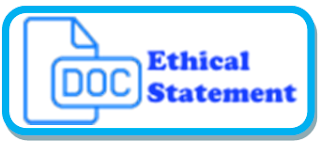TINGKAT KEMAMPUAN LITERASI DIGITAL DI KALANGAN DIFABEL
Abstract
The focus of this research is to determine the digital literacy ability of the blind disabled. Every citizen has the right to equality, easy access to information. This equality of rights is often constrained by the fact that the ease of access to information is not simply enjoyed by all people, as people with disabilities, especially those with disabilities, need special efforts and separate ways to improve their digital capabilities. Limitations do not prevent people with disabilities from enjoying and being able to access internet freely. Many digital literacy programs for the blind have been initiated by institutions, one of which is SLB-A Aisyiah, Ponorogo Regency. The purpose of this research is to determine the level of digital literacy ability of Aisyiah SLB-A students. The method used is descriptive quantitative with sampling using non-probability sampling, namely “a sampling technique that provides equal opportunities for each element (member) of the population. The population of this study was Aisyiah’s SLB-A students as many as 34 students at the junior high school level (SMP) and the senior high school level (SMA). The population is at the same time a sample or saturated sample. Analysis of the research data using statistics with the presentation of data through the formula mean and grand mean. “The mean is used to calculate the average value of the variables while the grand mean is used to calculate the total average. The main study is the assessment of digital literacy skills according to KOMINFO RI. The results showed that the digital literacy level of SLB-A students reached an average of 3.2 in the medium category. The first includes basic knowledge of conversational applications and social media which are categorized as high with an average result of 3.4. Second, is basic knowledge about information search engines, how to use and select data, the average is 3.25 in the medium category, the third position is basic knowledge about the digital landscape – internet and cyberspace, reaching 3.16 in the medium category, the average position is 3.16. the lowest average is basic knowledge about digital wallet applications, market stores, and digital transactions reaching 2.99 with less category
Keywords
Full Text:
PDFReferences
Adiba, Syifa, Febriyanto Febriyanto, Rama Shellarasa, And Saiful Afidhan. “Disabilitas Netra Dalam Berliterasi Informasi.” Jurnal Perpustakaan Pertanian 28, No. 1 (2020): 1. Https://Doi.Org/10.21082/Jpp.V28n1.2019.P1-6.
Aldwairi, Monther, And Ali Alwahedi. “Detecting Fake News In Social Media Networks.” Procedia Computer Science 141 (2018): 215–22. Https://Doi.Org/10.1016/J.Procs.2018.10.171.
American Library Association. “‘Digital Literacy.’ Welcome To ALA’s Literacy Clearinghouse.” Ala, 2022. Https://Literacy.Ala.Org/Digital-Literacy/.
APJII. “Press Conference: Survei Internet Indonesia 2023.” Jakarta, 2023. Https://Survei.Apjii.Or.Id/.
BPS. “Jumlah Penduduk Berumur 5 Tahun Ke Atas Menurut Kelompok Umur, Daerah Perkotaan/Perdesaan, Jenis Kelamin, Dan Tingkat Kesulitan Melihat, INDONESIA 2022.” Badan Pusat Statistik, 2022. Https://Sensus.Bps.Go.Id/Topik/Tabular/Sp2022/144/0/0.
Indonesia, Republik. “Undang-Undang (UU) Nomor 4 Tahun 1997 Tentang Penyandang Cacat.” Jakarta: BPK, 1997. Https://Peraturan.Bpk.Go.Id/ Details/37269.
———. “Undang-Undang No. 8 Tahun 2016.” Kementrian Pekerjaan Umum Dan Perumahan Rakyat. Jakarta, 2016. Https://Pug-Pupr.Pu.Go.Id/_Uploads/PP/UU. No. 8 Th. 2016.Pdf.
Jayusman, Iyus, And Oka Agus Kurniawan Shavab. “Studi Diskriptif Kuantitatif Aktivitas Belajar Mahasiswa Dengan Menggunakan Media Pembelajaran Learning Management System (Lms) Berbasis Edmodo Dalam Pembelajaran Sejarah.” Jurnal Artefak 7, No. 1 (2020): 13. Https://Doi.Org/10.25157/Ja.V8i1.3180.
Kominfo. “Status Literasi Digital 2023.” Kominfo, No. November (2023): 1–76. Kurnia, Novi, And Santi Indra Astuti. “Peta Gerakan Literasi Digital Di Indonesia: Studi Tentang Pelaku, Ragam Kegiatan, Kelompok Sasaran Dan Mitra Yang Dilakukan Oleh Japelidi.” Informasi 47, No. 2 (2017): 149. Https://Doi.Org/10.21831/Informasi.V47i2.16079.
Kurnia Novy, And Lestari Nurhajati. Kolaborasi Lawan Hoaks. Angewandte Chemie International Edition, 6(11), 951–952., 2018.
Monggilo, Zainuddin Muda Z. Kurnia, Novi, Banyumurti Indriyatno. Panduan Literasi Media Digital Dan Keamanan Siber MUDA, Kreatif, Dan Tangguh Di Ruang Siber, 2020.
Monggilo, Zainuddin Muda, Novi Kurnia, Yudha Wirawanda, Yolanda Presiana Devi, Ade Irma Sukma, Citra Rosalyn Anwae, Indah Wanerda, And Santi Indra Astuti. Cakap Bermedia Digital. Jakarta, 2021. Http://Literasidigital.Id/Books/Modul-Cakap-BermediaDigital/.
Mulyadi, Mohammad. “Penelitian Kuantitatif Dan Kualitatif Serta Pemikiran Dasar Menggabungkannya [Quantitative And Qualitative Research And Basic Rationale To Combine Them].” Jurnal Studi Komunikasi Dan Media 15, No. 1 (2019): 128.
Nasrullah, Rullie, Wahyu Aditya, Tri Indira Satya, Meyda Noorthertya Nento, Nur Hanifah, Miftahussururi, And Qori Syahriana Akbari. “Materi Pendukung Literasi Digital.” Kementerian Pendidikan Dan Kebudayaan, 2017, 43. Http://Gln.Kemdikbud.Go.Id/Glnsite/Wp-Content/Uploads/2017/10/Literasi-DIGITAL.Pdf.
———. Materi Pendukung Literasi Digital. Kementerian Pendidikan Dan Kebudayaan. Vol. 20, 2017. Http://Gln.Kemdikbud.Go.Id/Glnsite/ Wp-Content/Uploads/2017/10/Literasi-DIGITAL.Pdf.
Poerwanti, Sari Dewi, Sukron Makmun, And Amhar Davi Dewantara. “Jalan Panjang Menuju Inklusi Digital Bagi Penyandang Disabilitas Di Indonesia.” Journal Of Urban Sociology 1, No. 1 (2024): 44. Https:// Doi.Org/10.30742/Jus.V1i1.3536.
Prestianta, Albertus Magnus, FX Lilik Dwi Mardjianto, And Hargyo Tri Nugroho Ignatius. “Meta Analisis Platform Media Digital Ramah Penyandang Disabilitas.” LUGAS Jurnal Komunikasi 2, No. 2 (2018): 69–80. Https://Doi.Org/10.31334/Ljk.V2i2.264.
PUSDATIN KEMKES RI. “Situasi Disabilitas.” Pusat Data Dan Informasi Kementrian Kesehatan RI, 2019, 1–10.
Rodin, Rhoni, And Ade Dwi Nurrizqi. “Tingkat Literasi Digital Mahasiswa Jurusan Ilmu Perpustakaan Dalam Pemanfaatan E-Resources UIN Raden Fatah Palembang.” Pustakaloka 12, No. 1 (2020): 72–89. Https:// Doi.Org/10.21154/Pustakaloka.V12i1.1935.
Samsu. Metode Penelitian: Teori Dan Aplikasi Penelitian Kualitatif, Kuantitatif, Mixed Methods, Serta Research & Development. Diterbitkan Oleh: Pusat Studi Agama Dan Kemasyarakatan (PUSAKA), 2017.
Sugiyono, Dr. “Metode Penelitian Pendidikan Pendekatan Kuantitatif, Kualitatif Dan R&D,” 2019. Susilana, Rudi. “Modul Populasi Dan Sampel.” Modul Praktikum, 2015, 3–4. Http://File.Upi.Edu/Direktori/DUAL-MODES/PENELITIAN_ PENDIDIKAN/BBM_6.Pdf.
Widoyoko, Ekoputro. Teknik Penyusunan Instrumen Penelitian Yogyakarta: Pustaka Pelajar. Yogyakarta: Pustaka Pelajar, 2017.
DOI: https://doi.org/10.18326/pustabiblia.v8i1.87-108
Refbacks
- There are currently no refbacks.
Copyright (c) 2024 Pustabiblia: Journal of Library and Information Science

This work is licensed under a Creative Commons Attribution-NonCommercial-NoDerivatives 4.0 International License.
===========================================================================
Perpustakaan Institut Agama Islam Negeri (IAIN) Salatiga
Jl. Lingkar Salatiga Km. 2 Pulutan, Sidorejo,
Kota Salatiga, Jawa Tengah 50716,
Telp. (0298) 323706 – Fax. (0298) 323433
===========================================================================
Technical Support:Email : wiji.suwarno@gmail.com
Phone : +62 819-1433-5525



